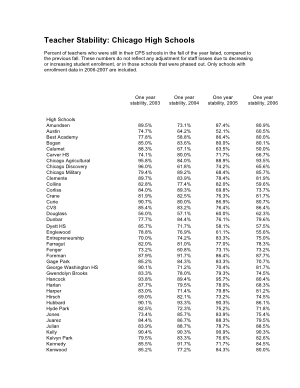In this report, we examine the degree to which teacher mobility is problematic in Chicago Public Schools (CPS) and look at the factors associated with high mobility rates, including teachers’ background characteristics, school structure, students’ characteristics, and workplace conditions.
This report reveals that about 100 Chicago schools suffer from chronically high rates of teacher turnover, losing a quarter or more of their teaching staff every year, and many of these schools serve predominantly low-income African American children. In the typical Chicago elementary school, 51 percent of the teachers working in 2002 had left four years later, while the typical high school had seen 54 percent leave by 2006.
The authors examined the factors associated with high mobility rates, including teachers' background characteristics, school structure, students' characteristics, and workplace conditions. Workforce conditions such as principal leadership, teacher collaboration, student safety all influence stability. In elementary schools, teachers' perceptions of parents as partners in students' education are strongly tied to stability; in high schools, teachers tend to leave schools with the highest rates of student misbehavior. The data includes personnel records from about 35,000 teachers in 538 elementary schools and 118 high schools.
This study reflects the Consortium's commitment to study education issues that are top priorities in Chicago and districts nationwide. While some teacher mobility is normal and expected, high turnover rates can produce a range of organizational problems at schools, such as discontinuity in professional development, shortages in key subjects, and loss of teacher leadership. Previous research also indicates that schools with high turnover are more likely to have inexperienced, ineffective teachers.
Want to learn more about teacher stability rates at your school? Download these PDFs.




